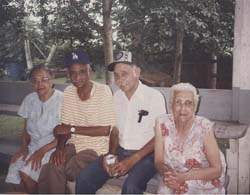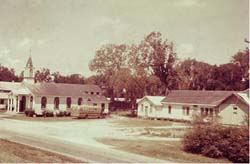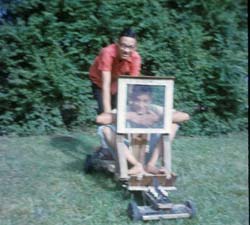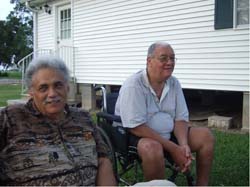Growing up in Davant, Louisiana: The Creoles of the East Bank of Plaquemines Parish
By Norbert Cazabat
Just south of New Orleans, on the east bank of the Mississippi River in Plaquemines Parish, there is a town called Davant. I grew up in that small town during the 1940s and 1950s, before leaving to attend high school at Saint Augustine's Seminary in Bay St. Louis, Mississippi. After graduation, I joined the Navy and subsequently was able to visit only during leaves and vacations.1
Traditionally, the people of Plaquemines Parish fell into three categories: whites, African Americans, and Creoles. I am a Creole. A lot of people have tried to define "Creole," but the term cannot be absolutely defined.2 The term "Creole" today usually refers to a person or persons whose ancestry includes a mixture of ethnicities. This mixture can include French, Spanish, Indian and/or African. In my case, my great-grandfather came from France on my father's side. My mother's ancestors came from what used to be Santo Domingo during the Haitian Revolution at the end of the 18th century, when thousands of free people of color fled Haiti for Louisiana. The closest definition of the term "Creole" is a mixture of various races or cultures that defines each Creole individually. To further complicate things, there are people who are not of mixed ancestry but consider themselves Creole. There are also Creoles who left Louisiana and lived their lives as white. The old people refer to them as passé, or passing for white.3 Today, using skin color to define a person is finally falling by the wayside, and this discussion is almost moot.
However, we still need to define, enjoy, teach, and pass on those memories that define us as who we are. Regretfully, there are not many of my older relatives alive today to share those memories with us. This essay was originally intended to pass on some of my memories to my children, grandchildren, nieces, and nephews, in hopes that at least some of the mystery of our family might be remembered. I hope that they may be of interest to other readers as well. Following are my personal remembrances, recollections, and opinions based on growing up in Plaquemines Parish between 1946 and 1959, before I left for school and then joined the Navy after graduation. Of course, many circumstances may have changed after the time that I left.
Home
Davant is a small, unincorporated town on the east bank of the Mississippi River, and most people were not very well off when I lived there. My mother and father raised five children in a small, three-room house. This was truly the house that Daddy built. The front room was my parents' bedroom, with my baby sister's crib. My three brothers and I slept in two beds in the middle room, where the family also watched television. The back room was the kitchen. In addition to being where all the food was prepared, the kitchen was the social gathering room for our visitors. In retrospect, it seems almost unbelievable that so many people could live in such a small space and get along. I guess the secret is we didn't know anything different, and although there were people with nicer and bigger homes, we never had a problem. Nor did I sense any issues that my mother and father had. As was the custom with most men in Davant, my father usually stopped at the local store, which had a bar attached to the rear of the store. My father would have several beers with his male friends, collect all of the local gossip, then return home with two beers (one for my mother and one for himself) to update my mother on the gossip.

Up the road a piece from my house was a store run by Prosper Ganier. The building had two entrances: one to the store in front, and one to the bar in the back portion of the building. Behind this building was a baseball field with bleachers. Every Sunday there were baseball games attended by blacks and Creoles.4 The teams were made up of local players who included my uncle O'Neil Domingue and my uncle Arthur (Zoon) Domingue. Some of these players were good enough to have played professional baseball. One summer while on summer vacation from the seminary, I had a chance to play with the local team. The pitcher was a young African American nicknamed Jo Jo. When Jo Jo was on, nobody could hit him. I'm sure that if Jo Jo had the opportunity to be watched by baseball scouts, he would have wound up in the majors. Unfortunately, where we lived and in the times we lived, there was no opportunity for kids like Jo Jo to be observed by any scouts.
Being 40 miles from New Orleans, it was difficult and sometimes impossible for Davant residents to get services that we take for granted today. Those included access to medical care, meat delivery, and businesses that sold fruits and vegetables, ice for the ice boxes (kept cold by blocks of ice stored at the top), or furniture. Once a week, Dr. Lindner would drive down Highway 39; if you wanted him to stop, you put out a red flag on the roadside. If you needed the iceman to stop, you put out the green flag. Mr. Sanders, the meat man, also came by once a week, usually on Saturday. The fruit man also came by weekly and sold both fruits and vegetables.
School
Most of the black and Creole children in the Davant area attended a Catholic grammar school initially called the Domingue School, later renamed Saint Martin de Porres (Figure 2). The school and church were built on property donated to the Catholic parish by my ancestors, the Domingues. The original school consisted of a single room which housed all of the grades. As the population of the area grew, the Domingue School also grew bigger. Later, a brick school was built and this became Saint Martin de Porres School. All of my brothers and sisters and cousins attended grammar school there. White children, however, did not attend the school. When I was growing up, schools were still racially segregated. When an African American or Creole child graduated from the grammar school, they went to Phoenix High School, while white children on the east bank of Plaquemines attended Woodlawn High School. When segregated public schools were abolished in the 1960s, the parish closed Woodlawn and turned it into a parish office building. White families began sending their children to private schools or academies created to accommodate them.5 Phoenix High School is still operating, although the building was destroyed in Hurricane Katrina.
Church
My family, like many older families in Plaquemines, was Catholic. There were three Catholic churches on the east bank: St. Thomas in the parish seat of Pointe-à-la-Hache, Saint Martin de Porres in Davant, and Assumption in the northern half of Plaquemines. Unlike schools, churches were not legally segregated, and I do not recall any hard-and-fast rules about which ethnic group attended which church. But customarily, most African Americans and Creoles from Davant and Pointe-à-la- Hache attended St. Martin de Porres in Davant, while white residents generally attended St Thomas Catholic Church in Pointe-à-la-Hache. In deference to the predominant ethnic group in each church, there were understood rules of seating. In Saint Martin de Porres, African Americans and Creoles sat in the front of the church, while white families sat in the back pew. At Saint Thomas, white churchgoers occupied the front of the church, and black and Creole worshippers sat in the rear.

Again, there were no official rules that defined the seating structure, but everyone seemed to follow an unspoken rule. In addition to the seating arrangements, the altar boys at Saint Martin were typically African American or Creole, while at Saint Thomas all of the altar boys were white. The exception to this rule was special occasions like weddings and funerals. If an African- American or Creole family had a wedding or funeral at Saint Thomas, altar boys would be either African American or Creole. The situation changed after I left, but I'm not sure at what point in history that change happened.
The Saint Martin de Porres church suffered significant damage from Hurricane Betsy in 1965 and was not repaired. The religious order that provided the priests to the parish opposed rebuilding it because they believed this might promote segregation among Creole, black and white parishioners. St. Thomas Catholic Church was badly damaged in Hurricane Katrina, but parishioners lobbied the archdiocese to restore the church, and it eventually re-opened.
Recreation
Though we didn't recognize it then, we were considered very poor. We learned to make a lot of the toys that we played with. Our property along the Mississippi provided us with woods to wander in, cut down trees, and hunt rabbits and possums toward the back of the property. The area around the houses offered space to play baseball and football. Across the road on the other side of the levee, the river provided us a swimming hole and an inexhaustible supply of lumber for our wagons, rabbit boxes and shrimp boxes. Baseball was a very important part of our upbringing. During the summertime, a game of baseball broke out almost every day. The yard in front of my mother's house became a baseball diamond. Anything hit over the road was a home run. We had to adjust our baseball diamond when my Uncle O'Neil added a room onto his house, covering first base. No big deal. The diamond was just a little skinnier than it was before, and it did not lessen the amount of fun we had playing ball in our front yard.
The Mississippi River brought us plenty of lumber, and my father, a carpenter, provided us with nails and tools. This enabled us to build things like wagons, using wheels and other spare parts from old lawn mowers that no longer worked. Some wagons had not only windshields, but spark plugs attached to the front end. Some versions were powered by old lawn-mower motors and had built-in clutches and brakes. I'm not sure if the features on the wagons were due to too much time on our hands or very inventive minds (Figure 3).
In the winter time, we made rabbit boxes and put them out in the woods behind our house. Rabbits typically use the same paths through the woods, so the boxes would be placed along paths that appeared to be used frequent. Though we never caught many rabbits, each time we did catch one, Mama didn't have to buy meat for dinner. In the summer we put out shrimp boxes in the Mississippi River. The boxes would be set out with shrimp bait, either purchased or table scraps. Our summertime record was even worse than our winter catches with the rabbit boxes. I realize now that these activities were a way to keep us occupied and have fun more than putting food on the table.6
Making a Living
Louisiana has always had an abundant supply of wildlife. In Plaquemines Parish, this included muskrats, nutria, raccoons, and minks for trapping; shrimps, crabs, and oysters for fishing; and rabbits and deer for hunting. All of the men in our family had multiple seasonal occupations. My father, for instance, would trap muskrat, mink, and nutria during the trapping season. During fishing seasons, he trawled for shrimp and dredged for oysters. A trawl needle was used to repair holes in shrimp trawls. My father was also a master carpenter and worked in the construction industry whenever there were homes to be built. Most of my uncles, and my older brother, did the same.

Trawl boats were not used solely for work, however. In the summer months we had what we called "bayou trips." Just about everyone owned a boat, and on these occasions, several boats would go out, carrying all the families. The boats then docked in a shallow bay, where we swam all day and ate the lunch we brought. Sometimes our father threw a trawl net for shrimp and crabs, and cooked them while we were docked. These trips were the highlights of our summers.
My mother, Eva Cazabat, also contributed to the financial wellbeing of our family, working as a seamstress, as did her sister Maria Domingue. My mother's house was on one side of our driveway, and Aunt Maria's was on the other side. (We called Aunt Maria "Nanan" because she was my older sister's godmother, and in French, godmothers are called nénaine.) My mother predominantly sewed for African Americans in the parish, and my aunt sewed for white residents. As in church seating, there was no real rule for this separation; it appeared to be the preference of the people they served. Both my mother and my aunt did everything from simple hemming to fairly elaborate wedding dresses. A few of my mother's wedding dress customers were pregnant. So as not to embarrass a young lady, my mother would leave an extra eight or ten inches of material when initially cutting the pattern. That allowed her to adjust the dress as the pregnancy advanced.
During summer vacation, we children were expected to work at odd jobs to help bring in money for the family. When I was growing up, we had many fruit trees on our property, including fig trees. All of the boys and girls and the extended family picked figs to sell, which usually meant waking up at five-thirty in the morning before it got too hot. Picking figs in the summertime can be painful. Usually you have to climb into the fig tree, and if the fig leaves brush your bare skin, they can cause severe itching. Once picked, figs also give off a white juice that irritates the skin. To protect ourselves while picking figs, we wore long-sleeved shirts in temperatures approaching 100 degrees with 90 percent humidity. The picked figs were then loaded into a basket to await the arrival of the fig man, who would buy them from us and take them to market. The fig man wasn't necessarily dishonest, but he would shake our basket of figs after it had been sitting for an hour or so. This would cause the figs to settle and make the basket appear only partially full. He fooled us the first time and did not pay us for full baskets. The next time, we kept half a basket of figs hidden, and when he shook the baskets, we used the extra figs to fill them up. He never tried that trick again.

Our back yard also had several large pecan trees. In the wintertime, we picked pecans and sold them to the pecan man. Picking pecans was a lot easier than picking figs. The pecans simply fell to the ground when they were ripe, making it simple to pick them up and load them into a bucket. No itchy leaves. No starting at five-thirty in the morning. No climbing trees. No 100-degree temperatures. No 90 percent humidity. It was just a matter of walking around and picking up the pecans off of the ground.
I really enjoyed growing up in Davant. There were obviously things that needed to be corrected but we, as kids, were oblivious of those things. We were encouraged, by my mother in particular, to go "up the road" (out of the parish). That phrase was meant to tell us that there was little possibility of a decent future for us in Davant. As it turns out, my brothers Maurice and Bernard were able to find work in Davant. After a stint in the Air Force, Maurice got a job at the coal plant in Davant. After retiring from the Air Force, Bernard became a general contractor, carpenter, electrician, and plumber. I think it's a shame that my children and my grandchildren will not have the opportunity to enjoy some of the things that we did as kids. We had very few material things, but we had a lot of love, a lot of freedom, a lot of space, and imaginations that created new worlds for us. This essay is my effort to help them understand what that life was like then.
Notes
1. This document was inspired by a conversation I had with Carolyn Ware of Louisiana State University who is interested in the Creoles of Plaquemines Parish. After that conversation, several thoughts came to mind that included things of interest to me as I was growing up.
2. Editor's Note: The term Creole has been used in Louisiana to describe white descendants of French and Spanish colonists, people of African and French/Spanish ancestry, or people of any mixed ancestry, as the author notes. Many Creoles in Plaquemines consider themselves primarily French and Indian. Sources on Louisiana Creoles include Carl Brasseaux, French, Cajun, Creole, Houma: A Primer on Francophone Louisiana (2005); Carl Brasseaux, Keith B. Fontenot, and Claude Oubre, Creoles of Country in the Bayou Country (1994); Virginia R. Dominguez, White By Definition: Social Classification in Creole Louisiana (1986); James Dormon, Creoles of Gulf in the Gulf South; Gwendolyn Midlo Hall, Africans in Colonial Louisiana: The Development of Afro- Creole Culture in the Eighteenth Century (1992); Sybil Kein, ed., Creole: The History and Legacy of Louisiana's Free People of Color (2000); and Gary Mills, The Forgotten People: Cane River's Creoles of Color (1977), among others.
3. Editor's note: Often this is phrased as "passant à blanc" (passing for white), or passer à blanc (to pass for white).
4. For more on the local importance of baseball, see Cheryl Hogan's "The Boys of Summer: African Americans and Baseball in Plaquemines Parish," in Louisiana Folklore Miscellany 21 (2011): 90-99.
5. Editor's Note: The federal court-ordered integration of Plaquemines Parish's public schools was a troubled and sometimes violent process that has been documented in James Conaway's Judge: The Life and Times of Leander Perez (1973), Glen Jeansonne's Leander Perez: Boss of the Delta (1977), among other books, and in numerous national newspapers, magazines, and television news programs in the 1960s.
6. Editor's Note: Norbert Cazabat today makes miniature shrimp boxes and rabbit boxes to demonstrate this disappearing art. They are available for purchase online at www.Creolecollections.com, and the author can be reached at norbert@cazabat.com for comments and suggestions. Louisiana Folklore Miscellany 22 (2012): 100-136.


